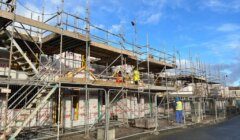Housing / Construction industry seeks more clarity on forthcoming large housing projects
THE LOCAL building industry has been praised for the quality of houses it builds and its commitment to providing apprenticeships.
But a delegation from the Federation of Master Builders (FMB) visiting Shetland this week also echoed concerns over the lack of clarity in scheduling forthcoming large housebuilding projects for the isles.
The start of the tendering process for the first phase of houses to be built on the Staney Hill site is understood to have slipped to summer next year, creating a few headaches in the local house building sector.
With the chronic undersupply of homes and long waiting lists for affordable housing not just in Shetland but across the country, housebuilding could potentially one of the industries of the future.
The new UK government wants to build 1.5 million new homes, and 50 to 60 per cent of these are supposed to be social or affordable.
(Left to right): Pam Wilson, president of FMB Scotland; DITT managing director Peter Tait; Gordon Nelson, FMB Scotland director, and Chris Carr, the national president of the Federation of Master Builders.
Photo: Hans J Marter/Shetland News
FMB national president Chris Carr said a close partnership, or even community co-operatives between public service house builders such as the council and Hjaltland Housing Association and the local construction industry, was a “no-brainer”.
“You got the answer right in front of you,” he said.
Referring to the ongoing infrastructure work at the Staney Hill site, paid for by the Scottish Government, he said he would an even closer partnership with the industry as it “was obvious that houses would be built there”.
Become a member of Shetland News
Earlier this week the industry met with councillors and officials as part of so-called Future Housing talks.
The other large housing building project that is likely to come off over coming years is the council’s redevelopment of the former Anderson High School site at the Knab.
But with the cut in the Scottish Government’s budget for social and affordable housing, it is unclear when the next tranche of money will be made available for projects such as these.
While the local industry has expressed frustration at the slow progress and the lack of detailed information regarding this, Carr called for “more meat on the bone” to allow building firms to plan their schedule of works and the size of their workforce.
“The frustrating thing is that it shouldn’t be as bad as it is, considering the quality builders you got here, and a local authority that wants to deliver new houses,” Carr said.
Projects like Hjaltland’s Staney Hill development are seen as vital for the survival of the local construction industry when private house building has suffered due to the high costs and the difficulties people have finding the right mortgage.
Carr said: “The quality of new houses here in Shetland are far superior to the ones in England. The energy efficiency is probably a decade ahead of what we are hoping to achieve.
“I have never seen so many companies training apprentices in such a small area, and I see the pride they are taking in this.
“There is a passion, and it is delivering a legacy to an island.”
While in Shetland, the FMB delegation attended the AGM of the Shetland Construction Training Group, a thriving organisation with around 90 members, the bulk of them construction companies.
The group co-ordinates training locally as it usually is too expensive for individual companies to send staff members away on courses.
Speaking on behalf of the group, DITT managing director Peter Tait said: “It is more cost effective to bring a trainer to spend a week Shetland doing a variety of courses, and we all can tap into that.”
Become a member of Shetland News
Shetland News is asking its readers to consider paying for membership to get additional perks:
- Removal of third-party ads;
- Bookmark posts to read later;
- Exclusive curated weekly newsletter;
- Hide membership messages;
- Comments open for discussion.
If you appreciate what we do and feel strongly about impartial local journalism, then please become a member of Shetland News by either making a single payment, or setting up a monthly, quarterly or yearly subscription.























































































